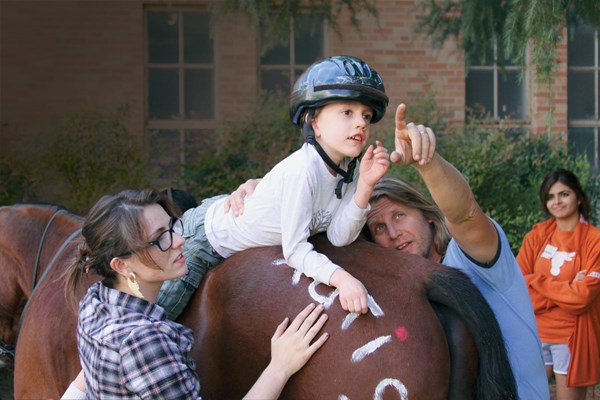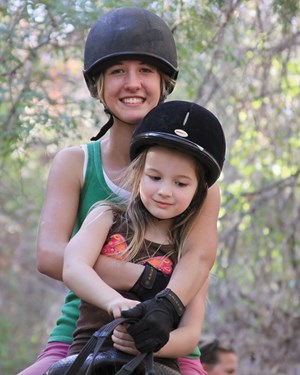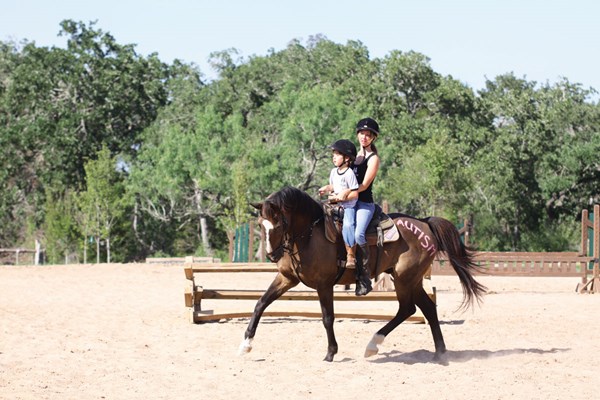
It’s an unseasonably cold winter day as I drive the short distance from the airport in Austin, Texas, to Elgin, home of New Trails, headquarters of the Horse Boy Foundation, the Horse Boy Method and the Horse Boy himself, Rowan Isaacson. Rowan, now 10 years old, is autistic. His father, Rupert Isaacson, a horseman and dressage rider, has designed a program using trained dressage horses to help autistic children and their families. I wanted to find out how this works, so Rupert suggested I come and see for myself. “I want to show dressage riders a new way to use their horses,” he told me, “a new way to harness their skills.”
Autism is a lifelong developmental disability affecting a child’s verbal, nonverbal and social skills. Rupert, an award-winning author and humanitarian, wrote an article in the February 2009 issue of Dressage Today in which he described how Rowan learned to speak while riding in front of him on Betsy, a Quarter Horse. In their quest to find more solutions to their son’s autism, Rupert and his wife, Kristin Neff, a University of Texas psychology professor and author of the book Self-Compassion, rode across Mongolia on horseback, which not only helped Rowan but also turned into a film documentary.
Back home, Rupert discovered that the more collected Betsy’s gaits became, the more Rowan spoke. Then he found that riding worked with other autistic children as well. It seemed there was a connection between riding a horse moving in collection and getting kids on the autism spectrum to communicate.
As I turn into the New Trails’ driveway at dusk, I am welcomed into the Isaacson home, decorated with masks and every-day items from the Bushmen of the Kalahari, with whom Rupert lived for some years. He now runs a human-rights organization that helps them in their efforts to keep their ancestral lands—but that’s another story. There is much to talk about as wine is poured and dinner is made. But this night is all about horses and dressage training and what Rupert has discovered in his search to help his son and others. I’m here to learn how dressage horses fit into the Horse Boy Method, why people are coming from all over the world to learn about it, and why folks like Linda Tellington-Jones (TTouch Method), Anna Ross Davies (British international dressage rider), Bernard Sachse (French gold-medal dressage Paralympian) and Alfredo Hernandez (California-based piaffe/ passage guru) have all endorsed the Horse Boy Method with enthusiasm.
Start with the Environment
Before we can get to the dressage, Rupert explains that he has learned he must begin by addressing a child’s environment. “Most kids on the autism spectrum suffer from an acute misfiring of their nervous systems,” he tells me. “They also have an overactive amygdala, the part of the brain that governs the fight-or-flight response. So anxiety, mental confusion and physical discomfort are very much a part of their everyday life.”
I learned that the amygdala creates cortisol, the stress hormone that makes you produce adrenaline so you can run away quickly from danger. But you don’t want lots of cortisol in your body at all times. Too much is toxic for the body. That’s why constant stress leads to health problems. Rupert says that everything he does in the Horse Boy Method is aimed at producing oxytocin— a hormone associated with positive feelings—and minimizing cortisol.
Most of us know what it’s like to feel motion-sick when sitting in the back of a car. “It’s even worse for autistic children,” explains Rupert, “who might suddenly feel like their clothes weigh 20 pounds or that a breath of wind suddenly feels like fire. When the wrong neurosensor switch gets thrown, meltdowns (tantrums) happen.” He explains that known triggers include things like fluorescent lighting, an overly loud refrigerator and industrial odors. With this in mind, Rupert wanted to create an environment that didn’t have these triggers. “It’s a natural environment: grass and sand that they can explore in a natural way. This calms everything down.”
Rupert points out that autistic children are under so much discomfort that their intellect gets buried or hidden. But researchers have found that the intellect of an autistic child is still intact, and it’s how he processes the information that’s different. I learned that there are many autistic people who grow up to have rich intellectual lives if the environmental stimuli can be calmed down, allowing their intellect to come to the fore.
“Horses have overactive amygdalas too,” Rupert explains, “and they solve their problems by running away from danger, just as many autistic people do. Horses are also nonverbal. But because they are social, we can develop a complex physical and verbal language with them across the species barrier and across the predator/prey barrier and do amazing things together.”
Apparently, people who work with young horses are often very good at working with autistic kids “because they instinctively know how to keep things calm, how to keep their body language soft, their gaze oblique, their tone of voice reassuring and so on. People without that background often get into difficult situations because they try to be more authoritarian with these kids,” says Rupert, adding that kids with autism are a bit like young horses because they want to please to a degree but are not going to pretend something works when it doesn’t. “These children can be very unforgiving if you mess up. Get the environment or the learning approach wrong, and they shut down.
So if something works for autism, it is going to work for all neurosensory conditions: attention deficit disorder, depression, grief, eating disorders, you name it.” (See “Learn More About Autism,” p. 55.)
Addressing Sensory Issues

At New Trails, Rupert has set up a play yard with swings and a trampoline, sandbox, slides and climbing frames. When children arrive, they gravitate there. Then Rupert does something that surprises me. He brings out a horse in full view of a child but begins working with the mother. He explains why: “When the kids arrive, they just want to play, but the mom is almost always very stressed out. Her marriage may be on the rocks. (Fully 80 percent of all autism marriages break up, leaving mostly single moms.) She gets told what a bad parent she is by complete strangers, and she feels guilty that she’s not giving her other children the time and attention they deserve. So while her kids are happy on the play equipment, I start with her to get her familiar with the horse.” After a few minutes of patting the horse, the mom may be ready to give him a hug or sit on him—whatever she is comfortable doing. Then she starts to feel some of her stress go away, says Rupert. “For non-horsey people, to move in close to a horse is a big deal. Many never get that opportunity. Meanwhile, the autistic child over on the trampoline is taking everything in. He can see that mom is interacting with this animal and it is OK.”
While developing the Horse Boy Method, Rupert has learned how important it is to address the whole family. “The autistic son may benefit from our work,” he says, “but what if there is also a pony-mad sister who can’t take riding lessons because her brother’s needs take up all the family resources? We can give her lessons for free. Suddenly, the door to her dreams is blown wide open because of her brother’s autism. Suddenly everyone’s perspective of autism has changed. Is it closing doors or is it opening doors? Is it a problem or is it an adventure?”

At New Trails, the teachers “are basically the servants of the child,” says Rupert. “I have to honor any communication, even negative. If the child says, ‘I don’t want to ride,’ or ‘I want to get down,’ I say, ‘Thanks for telling me,’ and I put him down immediately. That builds trust. We do it organically that way, making the learning seem like play, never a chore—just as one should with a young horse.”
Now Add Dressage Principles
Once Rupert addresses the sensory issues and the child is comfortable with the horse, he moves on to riding. “We use dressage but not dressage saddles. Since we ride holding the child in front of us, we need a Western saddle.” He says that when you sit behind the child, you can provide rhythm and cadence. “Everything works to rhythm,” he says, rhythmically snapping his fingers. “When you work at a rhythmic canter, particularly a soft collected canter, you get a euphoric response from the child because that hip-rocking rhythm causes the body to produce the feel-good hormone oxytocin.” He says this is why people love riding in collection. “When the horse is dancing lightly underneath you and rocking your hips like that, whether in piaffe, passage or terre-aterre [canter on the spot], our bodies get flooded with oxytocin. I discovered this early with Rowan: When I rode Betsy in ever-greater collection, he would respond with euphoric laughter and then waterfalls of words. Who would have thought that riding in collection and lightness would actually be healing for the nervous system and the brain?”

Rupert says it’s not just about oxytocin. Other valuable components include the deep pressure the child feels when being held. Autistic children seek out deep pressure. He has discovered that any movement that makes you find and refind your balance from moment to moment causes the learning receptors of the brain to open up. “Usually that’s a high alert, stress-type situation,” he says. “But by riding the horse in collection, you replace that stress with oxytocin— with bliss. So the child is suddenly in the optimum environment for receiving and retaining information.”
I watch Iliane Lorenz—a German-trained dressage rider who has helped Rupert develop his program—mount a big bay Dutch Warmblood called Marvel. She takes a feedbag stuffed with straw (called Freddy) and shows me how they begin teaching new instructors. She talks to Freddy as if it were a real child, offering him choices of where to go and at what pace. Frequently, kids on the autism spectrum, even if they are not verbal, are taking in much more than you think they are, so Rupert and Iliane talk to them as if they are verbal.

Once a child has been riding for a little while, the work at the canter begins. The canter needs to be as cadenced and as rocking as possible. Iliane points out a benefit for the teacher: “When you have to sit with the child in front, you can’t tilt forward on the horse,” she says. “You have to sit up, hold the horse just with your seat, and in the end, it makes you a better rider.”
Teach Perspective
Once the child is comfortable sitting in front of the rider, Iliane demonstrates how you can play tag on horseback to teach rule-based games—a vital part of developing a child’s ability to do what Rupert calls “perspective-taking” and what psychologists call “theory of mind.” “Now you can start teaching academics like math,” he says. Iliane rides a 20-meter circle, showing how you can teach the child what it means to divide a whole into a half or a quarter. In this work, the horse must assist by moving smoothly from halt to canter to halt.
When a child is too big to sit in front of a teacher, “We long line them,” says Rupert. He explains that he can still use piaffe, passage and even canter in-hand to provide the same steady tempo and rocking movement that opens up the learning receptors of the brain.
Rupert says that for dressage people, this kind of work “feeds our souls. We’re training our horses in the optimal way and applying the thing we love to do, which is dressage, for healing. So it’s a two-way street. We are not just giving up all our energy to these kids and burning out. We are getting an amazing response from our horses, which we love, and seeing a different part of the horse come out.” He thinks that as dressage riders, we tend to concentrate too much on our faults. “We need to correct our positions, yes,” he says, “but can’t we focus on the positive as well? I know the horses prefer it when we are in a positive frame of mind.”
As we walk through the woods the short distance from New Trails to his house, Rupert suggests that one of the best things we can do as dressage riders and horse owners is to make our barns a place where families can come together to exchange information, to find support and not be judged. He says it would be easy for people to make a small play area for children and use some of their dressage horses for this kind of work. “Working in this way becomes very nourishing and fulfilling for everyone,” he says.
Learn Self-Advocacy
I learn that the final stage, or goal, of the Horse Boy Method is self-advocacy, which Rupert explains is similar to self-carriage in a horse. “A horse that is carrying itself is safer and is in full control. It’s the same with humans. We are more effective when we are self-contained and able to speak for ourselves. So our aim, by the time the kids are entering adolescence, is to have filled them with enough confidence through the whole progression: from the right environment to the sensory work with the parents then the kids to riding a horse into the exterior world to working on the perspective-taking and rule-based games, then doing actual academics up there in the saddle until finally they can speak for themselves. When we can advocate for ourselves like this, we have acquired the most important survival tool—the ability to make a case for ourselves, persuade others to our point of view.”
Driving home the next day, my head is spinning as I digest all the information I’ve received about autism and the Horse Boy Method. And there is so much more to learn. One thing I know for sure: The creativity, persistence and dedication I witnessed remind me of dressage riders in general and how well they understand this kind of lifelong passionate commitment.











